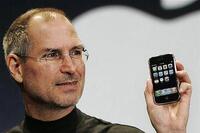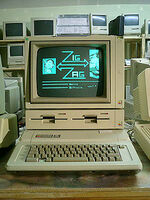 Yesterday the world was shaken with the news of Steve Jobs' passing. For some of us, it did not come as that much of a surprise. My wife is a gastroenterology RN at one of the country's top hospitals, and she is all too familar with pancreatic cancer. So we knew that for Steve, it was just a matter of time. But no one can deny that this man truly left his mark on the world during his relatively short lifetime.
Yesterday the world was shaken with the news of Steve Jobs' passing. For some of us, it did not come as that much of a surprise. My wife is a gastroenterology RN at one of the country's top hospitals, and she is all too familar with pancreatic cancer. So we knew that for Steve, it was just a matter of time. But no one can deny that this man truly left his mark on the world during his relatively short lifetime.
It seems hard for me to realize that he was one year younger than I am, yet had accomplished so much beginning at such an early age. Apple was started when Steve was just 21. When I was 21, I was still in college, and only one year into working on a Masters Degree. I thought I was ahead of the game, having entered college at only 16, and nailing a diploma to the wall while still only 20.
Yet here was Steve Jobs and Steve Wozniak, already changing the world! But at the time, I hadn't gotten into computers, and the top man on my "wish I could be like him" list at the time was Steven Spielberg.
I didn't get into home computing until the early 1980's. My first machine was a used, Apple IIe. I needed it for desktop publishing -- as I was the editor of the sound union's newletter/journal, along with being Marketing Director over at Skyline Productions (a prominent production sound outfit in Hollywood). I had used my role as Editor of the journal to meet and befriend some of Hollywood's legendary sound mixers (a strategy that I recommend to all of my students who are trying to get started), and soon wound up trading my literary and marketing skills in return for learning the real business of big-time sound mixing!
Except for a modest retainer, what I received for my efforts was a place to hang my hat near the coffee machine, hobnob with the top names in the industry, learn their techniques, and go out on jobs whenever one of those guys was too busy to take the offer. I was no longer in the minor leagues; now I was pinch hitting for the majors, so to speak.
 But back to my Apple computer. It was state of the art for those days. I had a deluxe model, known as the CPM version, which had a whopping 64k of RAM as opposed to the standard 32k. Yes, I said k. Not gigs, not even megs. Just plain k. The unit took two 5.25 inch floppy disks. Each disk could store up to 120k per side, and could only access one side at a time. All of us "geeks" quickly learned that by punching a slot in the right place on the sleeve of the disk, we could fool the computer into thinking that this was a double-sided disk. An inside secret was that all of the major brand floppies were made with double sided media, but packaged and sold as either single sided or double sided (more expensive) product.
But back to my Apple computer. It was state of the art for those days. I had a deluxe model, known as the CPM version, which had a whopping 64k of RAM as opposed to the standard 32k. Yes, I said k. Not gigs, not even megs. Just plain k. The unit took two 5.25 inch floppy disks. Each disk could store up to 120k per side, and could only access one side at a time. All of us "geeks" quickly learned that by punching a slot in the right place on the sleeve of the disk, we could fool the computer into thinking that this was a double-sided disk. An inside secret was that all of the major brand floppies were made with double sided media, but packaged and sold as either single sided or double sided (more expensive) product.
One floppy drive served as our "C" drive. In other words, it stored the program application software. (On the Apple, it was only callled an A or B drive. We didn't actually have a C drive.) The other floppy was our "writable" drive for data storage.
The monitor screen was one color: white text against a green background. Graphics were similar to what one might find on an older "pong" videogame.
Jobs, being Jobs, was already telling the world what he thought they needed and what he thought that they didn't. Steve was just not into upper and lower case letters at the time, so the Apple computers arrived out of the box with an upper and lower case keyboard, but only typed in upper case. A "geek" thing was to open up the computer and solder a jumper wire or two in the right spots in order to convert the system to use both the upper and lower cases of the letters.
A few years later, the IBM PC's (XT and AT) became popular. My first XT computer had a huge 10 meg hard drive, and used the new smaller 740k floppies, To be compatible, it also had another drive for the older 5.25 media.
And so the great Apple vs PC race was up and running! Steve Jobs and company developed the Macintosh line, which trumped the PC in terms of its graphics capability. Macs became the machines of choice for ad agencies, filmmakers, and artists. PC's led the ranks for numbers crunching and data storage; as well as local networking.
One day, in true coprporate fashion, the suits who had invested in Apple woke up and decided that Jobs and Wozniak were too radical for their hugely successful company, and booted them both out.
Jobs started up NEXT computers, and Wozniak went off in other directions.
The suits realized that they knew a lot about wearing the right ties, and splitting stocks, but not enough about taking on the IBM giant and its clones.
Jobs was back at the helm of Apple.
Apple is a strange outfit. It is more suit than most wall street companies. The hippy encampments of Silicon Valley and the Pacific Northwest are a far cry from the home of the I-pod, I-phone, and Macs. Jobs had some amazing visions of the future, but also was notorious for micro-managing the day to day affairs of many of his departments. I have a friend who has been at Apple over a decade, and he told me that his group could not repaint their dingy and worn old office walls -- even at their own expense -- because Jobs could not decide upon the right color! Never mind that this was their office, and that they were going to paint on their own time and out of their own pocket to fix the place up.
So what is in the future for Apple? We have seen the movement away from the power Macs to the consumer smart tools. With Jobs out of the picture, will Apple continue to care about making the Macs appeal to the power users, or just cave completely into a line of "designer" thin-books & tabliets for the light users (email, office apps).
Will the hidden genius of the here to fore, micro-managed employees be allowed to finally blossom? Will the new ideas and visions continue to erupt? Or will the suits finally take over and squash anything that seems radical, and turn Apple from an HBO into an NBC?
Tell me what you think?